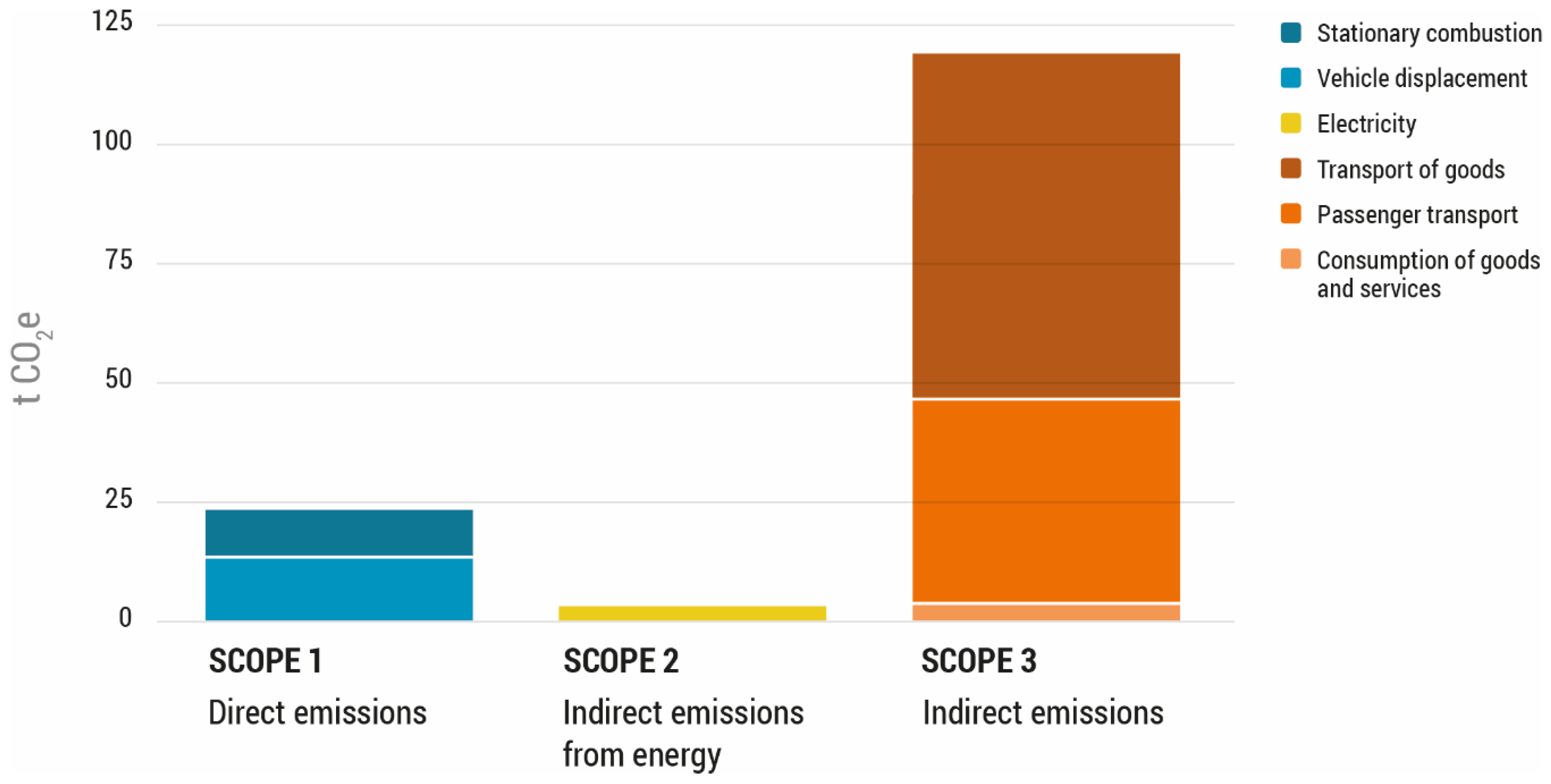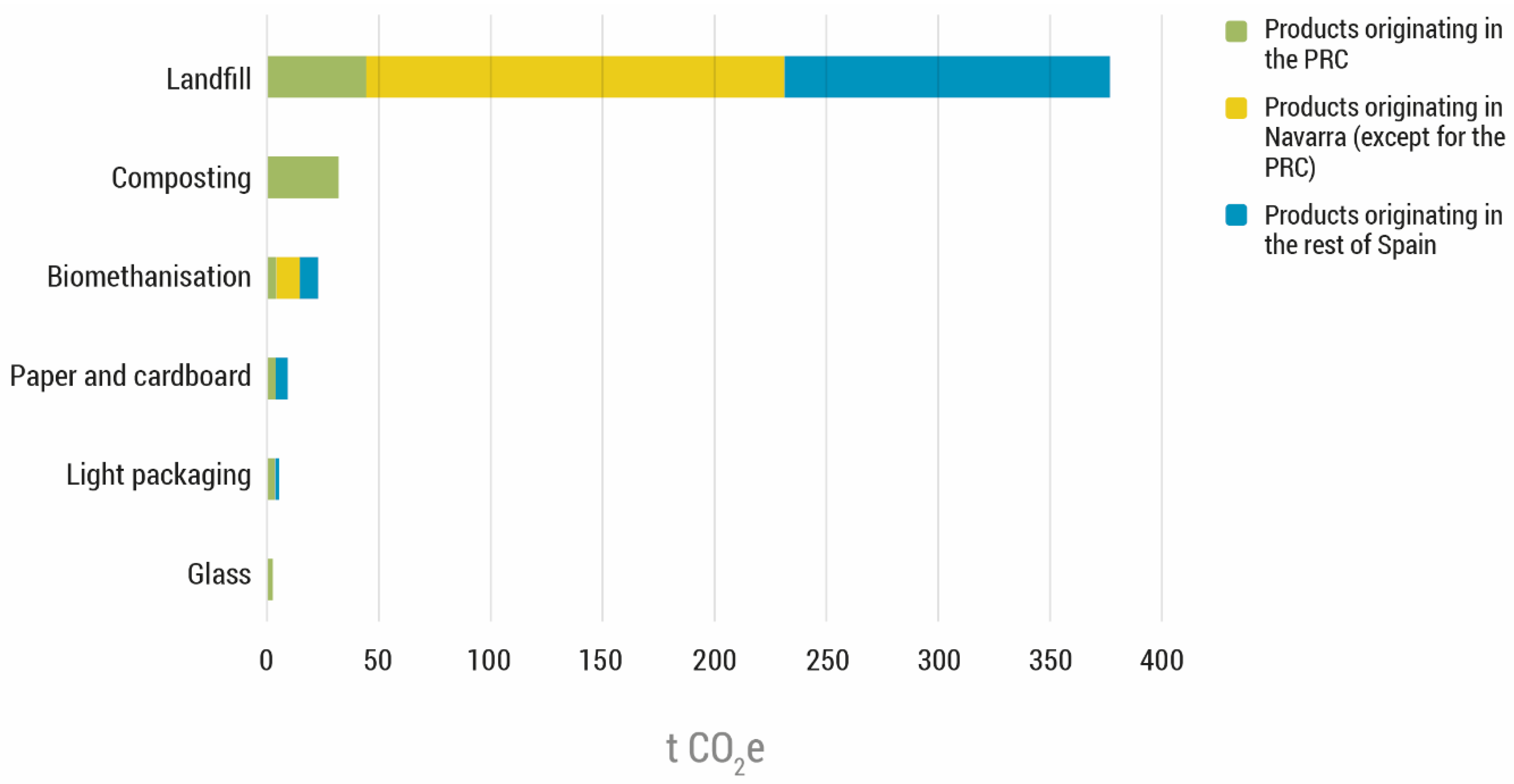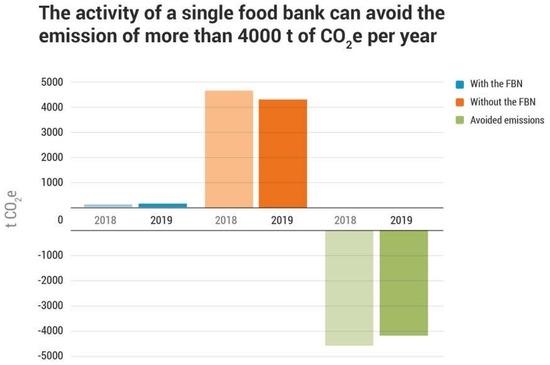Food Banks against Climate Change, a Solution That Works: A Case Study in Navarra, Spain
Abstract
1. Introduction
2. Materials and Methods
2.1. Greenhouse Gas Emission Assessment and Methodology
2.1.1. Boundary Definition
2.1.2. Identification of Emissions
2.1.3. Calculation of Emissions
2.2. Scenario with the Food Bank of Navarra
- Agrifood industries: approximately 104 donor companies were responsible for supplying food to the FBN.
- Fruit and vegetable producer organisations (FVPOs): within the framework of the regulation of Spanish markets, the FVPOs delivered fresh fruit and vegetables to all food banks.
- The Pamplona Region Commonwealth (PRC): This organisation collected foods from 67 shops as well as from 15 distribution companies on a daily basis, which was all perfectly consumable. These foods were donated because they had an early expiry date or the packaging containing them was defective, which classified them as unmarketable foodstuffs.
- Twice a year, solidarity campaigns called Grandes Recogidas (large food collections) were organised, which consisted of collecting food that was requested from the general public and from distribution companies.
- European Aid Fund for the Most Deprived: this programme consisted of the purchase of food on the market through a public tendering procedure for its subsequent supply to partner distribution organisations, in this case the FBN [36].
- Other food banks: the FBN helped, in 2018 alone, with the redistribution of 93 tonnes of food received from 19 food banks that were located throughout Spain.
2.3. Scenario without the Food Bank of Navarra
2.3.1. Additional Food Production Data Collection
2.3.2. Waste Treatment Data Collection
- The Pamplona Region Commonwealth: 778 tonnes;
- The sources of food supply to the FBN that were located in the PRC’s area included: the surplus food donated by agrifood companies (i.e., manufacturers and distributors) (54%); the daily PRC collection for the FBN (41%); and the surplus food from the fruit and vegetable producer organisations (5%).
- The percentages of the different waste fractions were based on the specific data from the PRC, published in the 2018 “Inventory of household and commercial waste” of the Government of Navarra [40]; this was in addition to the study regarding the characterisation of household waste in 2018, which was carried out by the Office for Waste Prevention and Promotion of the Circular Economy of the PRC [41].
- The rest of Navarra: 853 tonnes;
- In the rest of Navarra, excluding the PRC, the source of donated food was the surplus food donated by agrifood companies (manufacturers and distributors). The percentages of the different waste fractions were based on the data from the Government of Navarra [40].
- The rest of Spain: 1136 tonnes. Finally, the sources supplying food to the FBN from the rest of Spain included the surpluses donated by FVPOs (71%), the agrifood companies (manufacturers and distributors) (21%), and other food banks (8%).
- Of all the autonomous communities that were consulted, only the Generalitat de Cataluña provided the details of the final waste treatment. Due to this lack of publicly available information in most of the Spanish Autonomous Communities, it was assumed that these companies followed a similar waste management pattern to that of the Navarran (excluding PRC) and Catalan donor companies. In other words, for the “rest of Spain”—with the exception of Catalonia—the averages of the final waste treatments of the Comunidad Foral de Navarra and the Generalitat de Cataluña were assumed.
2.4. Description of the Carbon Balance: A Comparison of the Emissions with and without the Actions of the Food Bank of Navarra
3. Results
3.1. Greenhouse Gas Emissions in the Scenario with the Food Bank of Navarra
3.1.1. Carbon Footprint of the Food Bank of Navarra
3.1.2. Carbon Reduction Plan
3.2. Greenhouse Gas Emissions in a Scenario without the Food Bank of Navarra
3.2.1. GHG Emissions from Additional Food Production
3.2.2. GHG Emissions from Waste Management
3.3. Comparative Analysis of GHG Emissions “with” and “without” the Activities of the Food Bank of Navarra
3.4. Verification of the Results in Two Different Years
3.4.1. Scenario with the Food Bank of Navarra
3.4.2. Scenario without the Food Bank of Navarra
3.4.3. Comparative Analysis with and without the Actions of the Food Bank of Navarra
4. Discussion
4.1. Research Results Comparison with Previous Studies
4.2. Implications of the Study
4.3. Limitations of this Study
5. Conclusions
Supplementary Materials
Author Contributions
Funding
Data Availability Statement
Acknowledgments
Conflicts of Interest
Abbreviations
| AD | Activity data |
| ADEME | French Agency for Ecological Transition |
| CO2e | CO2 equivalent |
| E | Emission of greenhouse gases |
| EF | Emission factor |
| FBN | Food Bank of Navarra |
| FVPO | Fruit and vegetable producer organisation |
| GHG | Greenhouse gas |
| PRC | Pamplona Region Commonwealth |
| SDG | Sustainable development goal |
| US | The United States of America |
References
- FAO. Food Wastage Footprint & Climate Change; Food and Agriculture Organization of the United Nations: Rome, Italy, 2015; Available online: https://www.fao.org/3/bb144e/bb144e.pdf (accessed on 21 September 2022).
- Parfitt, J.; Barthel, M.; Macnaughton, S. Food Waste within Food Supply Chains: Quantification and Potential for Change to 2050. Philos. Trans. R. Soc. B Biol. Sci. 2010, 365, 3065–3081. [Google Scholar] [CrossRef] [PubMed]
- FAO. The State of Food and Agriculture, Moving Forward on Food Loss and Waste Reduction; Food and Agriculture Organization of the United Nations: Rome, Italy, 2019; Available online: http://www.fao.org/3/ca6030en/ca6030en.pdf (accessed on 21 September 2022).
- EU Platform on Food Losses and Food Waste. Recommendations for Action in Food Waste Prevention. 2019. Available online: https://food.ec.europa.eu/system/files/2021-05/fs_eu-actions_action_platform_key-rcmnd_en.pdf (accessed on 11 November 2022).
- United Nations Environment Programme. Food Waste Index Report 2021; United Nations Environment Programme: Nairobi, Kenya, 2021; Available online: https://www.unep.org/resources/report/unep-food-waste-index-report-2021 (accessed on 21 September 2022).
- Cuellar, A.D.; Webber, M.E. Wasted Food, Wasted Energy: The Embedded Energy in Food Waste in the United States. Environ. Sci. Technol. 2010, 44, 6464–6469. [Google Scholar] [CrossRef] [PubMed]
- de Sadeleer, I.; Brattebø, H.; Callewaert, P. Waste prevention, energy recovery or recycling—Directions for household food waste management in light of circular economy policy. Resour. Conserv. Recycl. 2020, 160, 104908. [Google Scholar] [CrossRef]
- FAO. Food Wastage Footprint, Impacts on Natural Resources: Summary Report; Food and Agriculture Organization of the United Nations: Rome, Italy, 2013; Available online: https://www.fao.org/3/i3347e/i3347e.pdf (accessed on 21 September 2022).
- Amicarelli, V.; Lagioia, G.; Bux, C. Global warming potential of food waste through the life cycle assessment: An analytical review. Environ. Impact Assess. Rev. 2021, 91, 106677. [Google Scholar] [CrossRef]
- Kummu, M.; de Moel, H.; Porkka, M.; Siebert, S.; Varis, O.; Ward, P. Lost food, wasted resources: Global food supply chain losses and their impacts on freshwater, cropland, and fertiliser use. Sci. Total Environ. 2012, 438, 477–489. [Google Scholar] [CrossRef] [PubMed]
- Marston, L.T.; Read, Q.D.; Brown, S.P.; Muth, M.K. Reducing Water Scarcity by Reducing Food Loss and Waste. Front. Sustain. Food Syst. 2021, 5, 85. [Google Scholar] [CrossRef]
- Penalver, J.G.; Aldaya, M.M. The Role of the Food Banks in Saving Freshwater Resources through Reducing Food Waste: The Case of the Food Bank of Navarra, Spain. Foods 2022, 11, 163. [Google Scholar] [CrossRef]
- Scherhaufer, S.; Moates, G.; Hartikainen, H.; Waldron, K.; Obersteiner, G. Environmental impacts of food waste in Europe. Waste Manag. 2018, 77, 98–113. [Google Scholar] [CrossRef]
- Tonini, D.; Albizzati, P.F.; Astrup, T.F. Environmental impacts of food waste: Learnings and challenges from a case study on UK. Waste Manag. 2018, 76, 744–766. [Google Scholar] [CrossRef]
- Xu, X.; Sharma, P.; Shu, S.; Lin, T.S.; Ciais, P.; Tubiello, F.N.; Smith, P.; Campbell, N.; Jain, A.K. Global greenhouse gas emissions from animal-based foods are twice those of plant-based foods. Nat. Food 2021, 2, 724–732. [Google Scholar] [CrossRef]
- MAPA. Spanish Strategy “More Food, Less Waste”; The Spanish Ministry of Agriculture, Fisheries and Food: Madrid, Spain, 2013; Available online: https://menosdesperdicio.es/sites/default/files/documentos/relacionados/spanish_strategy_more_food_less_waste.pdf (accessed on 21 September 2022).
- EPA. Inventory of U.S. Greenhouse Gas Emissions and Sinks. The United States Environmental Protection Agency: Washington, DC, USA, 2022. Available online: https://www.epa.gov/system/files/documents/2022-04/us-ghg-inventory-2022-main-text.pdf (accessed on 21 September 2022).
- Food Bank of Navarra Foundation (FBN). Food Bank of Navarra Foundation. Available online: https://bancoalimentosnavarra.org/ (accessed on 21 September 2022).
- ISO 14067; 2018 Greenhouse Gases—Carbon Footprint of Products—Requirements and Guidelines for Quantification. International Organization for Standardization (ISO): Geneva, Switzerland, 2018.
- Albizzati, P.F.; Tonini, D.; Chammard, C.B.; Astrup, T.F. Valorisation of surplus food in the French retail sector: Environmental and economic impacts. Waste Manag. 2019, 90, 141–151. [Google Scholar] [CrossRef] [PubMed]
- Beretta, C.; Hellweg, S. Potential environmental benefits from food waste prevention in the food service sector. Resour. Conserv. Recycl. 2019, 147, 169–178. [Google Scholar] [CrossRef]
- Eriksson, M.; Strid, I.; Hansson, P.A. Carbon footprint of food waste management options in the waste hierarchy—A Swedish case study. J. Clean. Prod. 2015, 93, 115–125. [Google Scholar] [CrossRef]
- Eriksson, M.; Spångberg, J. Carbon footprint and energy use of food waste management options for fresh fruit and vegetables from supermarkets. Waste Manag. 2017, 60, 786–799. [Google Scholar] [CrossRef]
- Moult, J.A.; Allan, S.R.; Hewitt, C.N.; Berners-Lee, M. Greenhouse gas emissions of food waste disposal options for UK retailers. Food Policy 2018, 77, 50–58. [Google Scholar] [CrossRef]
- Al-Rumaihi, A.; McKay, G.; Mackey, H.R.; Al-Ansari, T. Environmental Impact Assessment of Food Waste Management Using Two Composting Techniques. Sustainability 2020, 12, 1595. [Google Scholar] [CrossRef]
- Bernstad, A.; la Cour Jansen, J. Review of comparative LCAs of food waste management systems—Current status and potential improvements. Waste Manag. 2012, 32, 2439–2455. [Google Scholar] [CrossRef]
- Reynolds, C.J.; Piantadosi, J.; Boland, J. Rescuing food from the organics waste stream to feed the food insecure: An economic and environmental assessment of Australian food rescue operations using environmentally extended waste input-output analysis. Sustainability 2015, 7, 4707–4726. [Google Scholar] [CrossRef]
- Damiani, M.; Pastorello, T.; Carlesso, A.; Tesser, S.; Semenzin, E. Quantifying environmental implications of surplus food redistribution to reduce food waste. J. Clean. Prod. 2021, 289, 125813. [Google Scholar] [CrossRef]
- Guilhem, J. Rapport Sur L’empreinte Environnementale Liee a L’activite de La Banque Alimentaire de Bordeaux & de La Gironde en 2015; Veolia: Bordeaux, France, 2016. [Google Scholar]
- López, B.L.; López-Bellido, G.R.J.; Fernández, G.P.; López-Bellido, G.M. Estudio de la huella de carbono del Banco de Alimentos Medina Azahara de Córdoba; Technical report; Research Group Eco-Efficient Cropping Systems, Córdoba University: Córdoba, Spain, 2020. [Google Scholar]
- Greenhouse Gas Protocol. Corporate Accounting and Reporting Standard; Revised Edition; World Business Council for Sustainable Development, World Resources Institute: Geneva, Switzerland, 2005; p. 114. Available online: http://www.ghgprotocol.org/ (accessed on 21 September 2022).
- Intergovernmental Panel on Climate Change (IPCC). Mitigation of Climate Change, Summary for Policymakers. 2022. Available online: https://report.ipcc.ch/ar6wg3/pdf/IPCC_AR6_WGIII_SummaryForPolicymakers.pdf (accessed on 21 September 2022).
- ISO/TR 14069; 2013 Greenhouse Gases—Quantification and Reporting of Greenhouse Gas Emissions for Organizations—Guidance for the Application of ISO 14064-1. International Organization for standardization (ISO): Geneva, Switzerland, 2015.
- UNE-EN ISO 14064-1; 2019 Greenhouse Gases—Part 1: Specification with Guidance at the Organization Level for Quantification and Reporting of Greenhouse Gas Emissions and Removals (ISO 14064-1:2018). Asociación Española de Normalización (UNE): Madrid, Spain, 2019.
- Ministerio para la Transición Ecológica y el Reto Demográfico (MITECO). Carbon Footprint Calculator. Available online: https://www.miteco.gob.es/es/cambio-climatico/temas/mitigacion-politicas-y-medidas/calculadoras.aspx (accessed on 21 September 2022).
- Uceda, G.; Afonso, A.; De los Ríos, I. Cátedra Bancos de Alimentos UPM: Retos Ante El Horizonte Post 2020. El Nuevo Enfoque de Los Bancos de Alimentos En España. Madrid, Spain. 2018. Available online: https://drive.google.com/file/d/1r92DsGszByH1q64N0Vjq3bbuufIw4gjv/view (accessed on 21 September 2022).
- Agence de la transition écologique (ADEME). Base de données Bilan Carbone, Base Carbone V11. Available online: https://www.bilans-ges.ademe.fr/en/accueil (accessed on 21 September 2022).
- Fundación Ecología y Desarrollo (ECODES). Prevención de la Contaminación e Impacto Climático en Función de la Selección de las Diferentes Alternativas de Alimentación. 2019. Available online: https://ecodes.org/documentos/4_Documentacion-MITECO.pdf (accessed on 21 September 2022).
- Observatory CO2 web of the Tatiana Pérez de Guzmán el Bueno Foundation, Cátedra de Ética Ambiental, Universidad de Alcalá. Available online: https://huellaco2.org/alimentos.php (accessed on 21 September 2022).
- Gobierno de Navarra. Residuos Domésticos y Comerciales, Inventario 2018; Gobierno de Navarra: Pamplona, Spain, 2019; Available online: http://www.navarra.es/NR/rdonlyres/02435035-9176-4658-9942-12D4961440B8/475058/2018domesticos.pdf (accessed on 21 September 2022).
- Gobierno de Navarra. Oficina de Prevención de Residuos y de Impulso de la Economía Circular, Limitaciones que Abren Puertas. 2018. Available online: https://oprec-navarra.com/limitaciones-abren-puerta/ (accessed on 21 September 2022).
- Ministerio para la Transición Ecológica y el Reto Demográfico (MITECO). Inventario Nacional de Gases de Efecto Invernadero. Gobierno de España. 2020. Available online: https://www.miteco.gob.es/es/calidad-y-evaluacion-ambiental/temas/sistema-espanol-de-inventario-sei-/Inventario-GEI.aspx (accessed on 21 September 2022).
- Oficina Catalana del Cambio Climático (OCCC). Calculation of GHG Emissions Derived from Municipal Waste Management; OCCC: Barcelona, Spain, 2020. [Google Scholar]
- Frankowska, A.; Schmidt Rivera, X.; Bridle, S.; Rodrigues Galdino, K.; Marielle, A.; Tereza da Silva, J.; Martins, C.A.; Rauber, F.; Levy, R.B.; Cook, J.; et al. Impacts of home cooking methods and appliances on the GHG emissions of food. Nat. Food 2020, 1, 787–791. [Google Scholar] [CrossRef]
- MITECO. Environmental Profile of Spain 2016; Ministerio para la Transición Ecológica y el Reto Demográfico: Madrid, Spain, 2017; Available online: https://www.miteco.gob.es/es/calidad-y-evaluacion-ambiental/publicaciones/pae_2016_en_lr_tcm30-448910.pdf (accessed on 21 September 2022).
- United Nation. Resolution Adopted by the General Assembly on 25 September 2015. 2015. Available online: https://documents-dds-ny.un.org/doc/UNDOC/GEN/N15/291/89/PDF/N1529189.pdf?OpenElement (accessed on 21 September 2022).
- Usubiaga, A.; Butnar, I.; Schepelmann, P. Wasting food, wasting resources: Potential environmental savings through food waste reductions. J. Ind. Ecol. 2017, 22, 574–584. [Google Scholar] [CrossRef]
- MAPA. Proyecto de Ley de Prevención de las Pérdidas y el Desperdicio Alimentario; Ministerio de Agricultura, Pesca y Alimentación: Madrid, Spain, 2022; Available online: https://www.congreso.es/public_oficiales/L14/CONG/BOCG/A/BOCG-14-A-107-1.PDF (accessed on 21 September 2022).
- Makov, T.; Shepon, A.; Krones, J.; Gupta, C.; Chertow, M. Social and environmental analysis of food waste abatement via the peer-to-peer sharing economy. Nat. Commun. 2020, 11, 1156. [Google Scholar] [CrossRef] [PubMed]
- Munesue, Y.; Masui, T.; Fushima, T. The effects of reducing food losses and food waste on global food insecurity, natural resources, and greenhouse gas emissions. Environ. Econ. Policy. Stud. 2014, 17, 43–77. [Google Scholar] [CrossRef]
- Nayak, D.; Saetnan, E.; Cheng, K.; Wang, W.; Koslowski, F.; Cheng, Y.; Zhu, W.Y.; Wang, J.; Liu, J.; Moran, D.; et al. Management opportunities to mitigate greenhouse gas emissions from Chinese agriculture. Agric. Ecosyst. Environ. 2015, 209, 108–124. [Google Scholar] [CrossRef]
- Bruno, M.; Thomsen, M.; Pulselli, F.M.; Patrizi, N.; Marini, M.; Caro, D. The carbon footprint of Danish diets. Clim. Chang. 2019, 156, 489–507. [Google Scholar] [CrossRef]
- Schanes, K.; Giljum, S.; Hertwich, E. Low carbon lifestyles: A framework to structure consumption strategies and options to reduce carbon footprints. J. Clean. Prod. 2016, 139, 1033–1043. [Google Scholar] [CrossRef]
- Jones, C.M.; Kammen, D.M. Quantifying Carbon Footprint Reduction Opportunities for U.S. Households and Communities. Environ. Sci. Technol. 2011, 45, 4088–4095. [Google Scholar] [CrossRef]






| Recommendation | GHG Emission in 2018 (t CO2e) | GHG Emission after Applying Recommendations (t CO2e) | Avoided GHG Emission (t CO2e) | Carbon Footprint of the FBN 2018 (t CO2e) | Carbon Footprint of the FBN after the Recommendations (t CO2e) | Carbon Reduction (%) |
|---|---|---|---|---|---|---|
| Change to renewable electricity service at the FBN headquarters in Tudela | 3 | 0 | 3 | 147 | 134 | 9 |
| Increase the use of public transport (bus) by 25% for staff traveling by car to the FBN * | 43 | 33 | 10 |
| Impact Category | Food Bank of Navarra (2018) (t CO2 e) | Food Bank of Cordoba (t CO2 e) | Food Bank of Bordeaux (t CO2 e) | |
|---|---|---|---|---|
| Food distributed | 2,767,536 kg | 451,769 kg | 4,500,000 kg | |
| Scenario with the food bank in T CO2 e | Fixed combustion | 9.6 | 11.2 | NA |
| Transportation fuel consumption | 14.8 | 69 | ||
| Transport of food inflows | 45.3 | 84.5 | ||
| Transport of food outflows | 27.7 | |||
| Transport of volunteers and staff | 43.2 | 21.55 | ||
| Electricity consumption | 3 | 5.6 | 1.9 | |
| Refrigerant gas recharge | 0 | NA | NA | |
| Consumption of goods and services | 3.6 | NA | 23.4 | |
| Scenario without the food bank T CO2 eq | Waste management | 443 | NA | 102.9 |
| Additional food production | 4272 | 564.6 | 8122 | |
| Comparative analysis | Scenario with the food bank Scenario without the food bank | 4568 | 547.9 | 8025 |
Publisher’s Note: MDPI stays neutral with regard to jurisdictional claims in published maps and institutional affiliations. |
© 2022 by the authors. Licensee MDPI, Basel, Switzerland. This article is an open access article distributed under the terms and conditions of the Creative Commons Attribution (CC BY) license (https://creativecommons.org/licenses/by/4.0/).
Share and Cite
Penalver, J.G.; Armijos, A.; Soret, B.; Aldaya, M.M. Food Banks against Climate Change, a Solution That Works: A Case Study in Navarra, Spain. Foods 2022, 11, 3645. https://doi.org/10.3390/foods11223645
Penalver JG, Armijos A, Soret B, Aldaya MM. Food Banks against Climate Change, a Solution That Works: A Case Study in Navarra, Spain. Foods. 2022; 11(22):3645. https://doi.org/10.3390/foods11223645
Chicago/Turabian StylePenalver, Josemi G., Alejandra Armijos, Beatriz Soret, and Maite M. Aldaya. 2022. "Food Banks against Climate Change, a Solution That Works: A Case Study in Navarra, Spain" Foods 11, no. 22: 3645. https://doi.org/10.3390/foods11223645
APA StylePenalver, J. G., Armijos, A., Soret, B., & Aldaya, M. M. (2022). Food Banks against Climate Change, a Solution That Works: A Case Study in Navarra, Spain. Foods, 11(22), 3645. https://doi.org/10.3390/foods11223645









